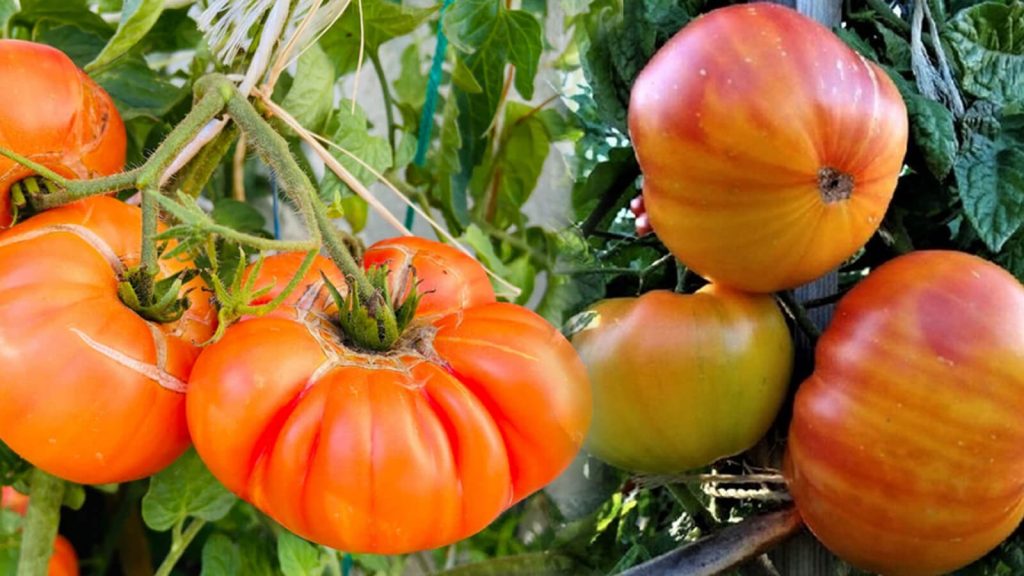“Meet the Pineapple Tomatoes!”
When one thinks of Pineapple tomatoes, the usual image that comes to mind is the classic round, red fruit commonly found in salads, sauces, and sandwiches. However, the world of tomatoes is far more diverse and exciting than we might realize. One such captivating variety is the “Pineapple Tomato,” known for its unique appearance, delightful flavor profile, and ability to add a tropical twist to your garden and palate.
Origins and Appearance:

The Pineapple Tomato (Solanum lycopersicum) is a heirloom tomato variety that stands out due to its distinctive appearance. Originating in the United States, this has been developed through careful selection and crossbreeding to bring about its exceptional characteristics. The name “Pineapple Tomato” is a nod to its appearance rather than its flavor – the fruit’s skin and flesh often have streaks of orange, yellow, and red, much like the colors of a pineapple. The tomatoes are usually large than the average cherry tomato but smaller than a typical beefsteak variety. The overall shape is flattened and ribbed, giving the fruit an attractive and whimsical look.
Cultivation of Pineapple tomatoes:
Farmers have discovered that growing these tomatoes is gratifying. They need well-draining soil, sufficient sunlight, and constant moisture, similar to other tomato types. Pineapple tomatoes can be grown in variety settings, such as elevated beds, gardens in the backyard, and even pots. The temperature range for growth is 60 degrees Fahrenheit to 85 degrees Fahrenheit (15°C to 29°C).
These Tomato seeds often germinate indoors. After the risk of frost has gone, the seedlings are transplanted outside. While the plants develop, periodic trimming and pinning are required to maintain optimum air circulation and stability for the fruit-laden branches.
Flavor Profile:
While the name might evoke thoughts of tropical sweetness, the flavor of this Tomatoes is more complex than one might imagine. These tomatoes have a well-balanced and tangy taste, with fruity undertones that set them apart from the usual tomato flavor. The higher sugar content gives them a mildly sweet flavor complemented by a refreshing acidity. The Pineapple Tomato’s taste is exciting on its own, in salads, or as a key ingredient in various culinary creations.
Culinary Uses:
The Pineapple Tomato’s unique flavor makes it a versatile ingredient in the kitchen. Its distinct appearance also adds visual appeal to dishes, making it a favorite among chefs and food enthusiasts. Here are a few ways to make the most of this tropical gem:

- Fresh Salads: Slice Pineapple Tomatoes and add them to salads with other fresh ingredients for a burst of color and flavor.
- Salsas and Relishes: The sweet-tangy flavor of this particular Tomatoes makes them an excellent choice for making salsas, relishes, and chutneys.
- Sandwiches and Burgers: Upgrade your sandwiches and burgers by adding slices of Pineapple Tomatoes for a juicy and flavorful element.
- Grilled Delicacy: Grilling these Tomatoes can enhance their natural sweetness and create a delightful smoky flavor that’s perfect as a side dish.
- Sauces and Pastes: While Pineapple Tomatoes are often enjoyed fresh and can create flavorful tomato sauces and pastes for pasta dishes and pizzas.
- Preservation: To enjoy the unique flavors of this tomato beyond their growing season, consider preserving them through methods such as canning, making sauces, or even drying them for later use. These preservation techniques can help you savor the essence of Pineapple Tomatoes throughout the year.
In Conclusion:
The Pineapple Tomato is a fascinating addition to the world of tomatoes, offering both gardeners and culinary enthusiasts a delightful experience. From its alluring appearance reminiscent of pineapple to its complex flavor profile that balances sweetness and tanginess, this tomato variety adds a touch of the tropics to your garden and your table. Whether enjoyed fresh, grilled, preserved, or incorporated into various dishes, the Pineapple Tomato is a testament to the diverse and flavorful possibilities the world of tomatoes offers.
Frequently Asked Questions About Pineapple Tomatoes
Q1: What are pineapple tomatoes?
A: Pineapple tomatoes are a unique heirloom tomato variety known for their large size, vibrant colors, and sweet, fruity flavor. They are often characterized by their yellow and red streaked flesh, which resembles the appearance of a pineapple.
Q2: What flavor are pineapple tomatoes?
A: These tomatoes have a flavor that is incredibly sweet, tropical, and frequently characterized as a blend of fruity and zesty elements. Depending on the growing environment and level of maturity, the flavor profile may vary slightly.
Q3: Are pineapple tomatoes determinate or indeterminate?
A: These tomato plants are typically indeterminate, meaning they continue to produce fruit throughout the growing season rather than setting fruit all at once.
Q4: How big do pineapple tomato plants grow?
A: This tomato plants can grow quite large, reaching heights of up to 6 feet (1.8 meters) or more. They often benefit from staking or caging to provide support for the heavy fruit clusters.
Q5: Can I save seeds from pineapple tomatoes for planting?
A: Yes, you can save seeds from ripe pineapple tomatoes for planting in subsequent years. Scoop out the seeds from a ripe tomato, rinse off the gel around them, and allow them to dry on a paper towel. Store the dried seeds in a cool, dry place.
Q6: How do I care for these tomato plants?
A: Plant these tomato seeds or seedlings in well-draining soil with plenty of sunlight. Space them according to the recommendations for indeterminate tomato varieties. Provide support for the plants using stakes or cages, and water consistently to keep the soil evenly moist.
Q7: When can I expect to harvest this tomatoes?
A: Pineapple tomatoes typically start ripening around 80 to 90 days after transplanting seedlings into the garden. The exact timing can vary based on growing conditions, but you can usually start harvesting the fruit in mid to late summer.
Q8: Can I grow pineapple tomatoes in containers?
A: Yes, you can grow pineapple tomatoes in containers, but keep in mind that they can grow quite large. Choose a large container (at least 5 gallons in size) and provide proper support for the plants as they grow. Regular watering and fertilization are essential for container-grown plants.
Q9: Can I use these tomatoes for salads and fresh eating?
A: Yes, these tomatoes are excellent for salads and fresh eating due to their unique flavor and vibrant colors. They can add a delightful sweetness and visual appeal to various dishes.
Q10: Are these tomatoes resistant to diseases?
A: Disease resistance can vary among different tomato varieties, including pineapple tomatoes. While they may not be as disease-resistant as some modern hybrid varieties, practicing good gardening practices, such as proper spacing and hygiene, can help minimize disease issues.
Please note that pineapple tomatoes, like other tomato varieties, may have specific care requirements based on your growing environment. Adjust your gardening approach accordingly for the best results.
Also read about the tree tomato here

